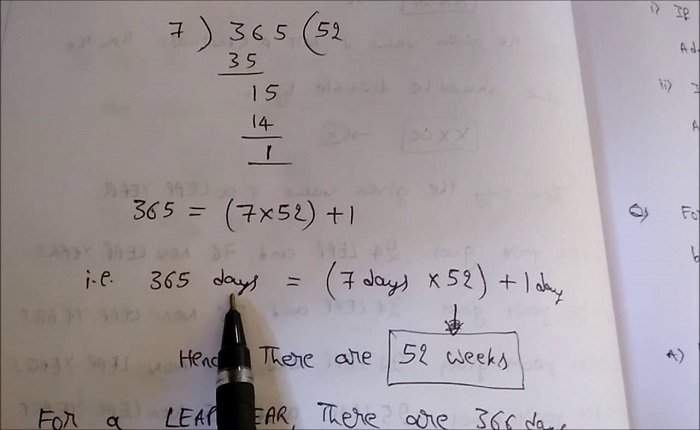How Many Weeks in a Year: A Detailed Breakdown

The question “how many weeks in a year” is simple yet essential to understanding how time is structured. While most people know there are 365 days in a common year, the division into weeks provides a practical way to measure and manage time. To answer the question clearly, there are 52 full weeks in a year, with one extra day left over in a common year and two in a leap year. This post will explore the concept of how many weeks in a year, the role of leap years, and the impact of weeks on various aspects of life.
The Basic Calculation: How Many Weeks in a Year?

To determine how many weeks in a year, we start with the basic fact that there are 365 days in a common year. By dividing 365 days by 7 (since there are 7 days in a week), we get approximately 52.14 weeks. This means that a common year contains 52 full weeks and one extra day. During a leap year, which has 366 days, the calculation is similar: 366 days divided by 7 equals 52.28 weeks, or 52 full weeks with two additional days. This simple arithmetic helps clarify how many weeks in a year and how the remaining days fit into the calendar.
What Is a Leap Year?
Understanding how many weeks in a year requires knowledge of leap years. A leap year occurs every four years to account for the fact that the Earth’s orbit around the Sun takes slightly more than 365 days—365.24 days, to be precise. To keep our calendar aligned with the Earth’s orbit, we add an extra day to the calendar every four years. This day is added to the end of February, making February 29 the leap day. In a leap year, there are 366 days, which also affects how many weeks in a year, leaving us with 52 full weeks and two extra days.
How Many Weeks in a Common Year vs. a Leap Year?
In a common year, there are 365 days, which is equivalent to 52 weeks and one additional day. This extra day doesn’t form a full week but is essential in maintaining the calendar’s accuracy. On the other hand, a leap year has 366 days, which means 52 weeks and two extra days. These two extra days play a crucial role in keeping our calendar aligned with astronomical events, such as the solstices and equinoxes. The distinction between common and leap years helps us understand the slight variation in how many weeks in a year we experience.
How Weeks Are Structured in the Calendar
The calendar year is divided into 12 months, and the distribution of how many weeks in a year often depends on how these months fall. Most months have 4 full weeks, but due to the variation in the number of days per month (ranging from 28 to 31), some months contain extra days beyond those 4 weeks. For instance, a month like March, which has 31 days, includes 4 full weeks plus 3 extra days. Understanding how weeks are structured in a calendar helps clarify how many weeks in a year and how those weeks are organized across different months.
Importance of Knowing How Many Weeks in a Year
Knowing how many weeks in a year is essential for various aspects of life, from planning work schedules to organizing personal events. For example, many work contracts are based on weekly commitments, making it crucial to understand how many working weeks are in a year. Similarly, budgeting, vacation planning, and even fitness goals often revolve around weekly schedules. By knowing how many weeks in a year, individuals can effectively manage their time and plan ahead, ensuring that their schedules align with the calendar.
How Many Workweeks in a Year?
If you’re wondering how many workweeks are in a year, it’s essential to factor in weekends and public holidays. In a typical year, with 52 full weeks, there are 260 weekdays, which are usually designated as workdays. However, public holidays and vacations can reduce this number. On average, people work about 48 to 50 weeks per year, depending on their location and company policies. Knowing how many workweeks in a year helps individuals plan their professional goals and manage their work-life balance.
How Many School Weeks in a Year?
For students, understanding how many school weeks in a year is essential for academic planning. The number of school weeks typically varies by country and educational system, but most schools operate for around 36 to 40 weeks a year, with summer breaks, winter vacations, and holidays accounting for the remaining weeks. Knowing how many school weeks in a year helps students and teachers structure their academic calendars, ensuring they have enough time to cover the necessary curriculum and prepare for exams.
How Holidays Affect How Many Weeks in a Year
Holidays can impact how many productive weeks there are in a year, as they break up the regular schedule of work or school weeks. For example, during the winter holiday season, many businesses and schools may close for extended periods, reducing the number of working or schooling weeks in the year. Additionally, holidays like New Year’s Day, Independence Day, and other public celebrations can result in long weekends, affecting how we perceive how many weeks in a year are fully productive. Understanding how holidays fit into the weekly structure can help in better planning throughout the year.
Impact of How Many Weeks in a Year on Time Management
Effective time management often revolves around understanding how many weeks in a year you have to achieve your goals. Whether you’re planning a long-term project, setting fitness goals, or working towards a financial objective, dividing your year into weekly segments can help you stay organized and on track. By breaking down tasks into weekly goals, you can make the most of the 52 weeks in a year and ensure that you meet your deadlines and objectives in a manageable and consistent way.
How Many Weeks in a Year by International Standards
Internationally, the concept of how many weeks in a year remains consistent across most calendar systems. The Gregorian calendar, which is used globally, divides the year into 52 full weeks, with the extra day or two added to the end. However, different cultures and religions may observe different calendars, such as the Islamic or Jewish calendars, which have varying structures. Despite these variations, the number of weeks in a year typically aligns with the Earth’s solar cycle, keeping time consistent for most international practices.
Conclusion
Knowing how many weeks in a year is more than just a mathematical fact—it is a valuable tool for effective planning, time management, and understanding the passage of time. Whether you’re organizing your work schedule, planning a vacation, or setting personal goals, understanding the division of time into weeks can provide clarity and help you optimize your life. With 52 full weeks in a common year and slightly more in a leap year, every week represents an opportunity to stay on track, achieve your goals, and make the most of your time.
FAQs
1. How many weeks are in a year?
There are 52 full weeks in a common year, with one additional day. In a leap year, there are 52 weeks and two extra days.
2. Why are there 52 weeks in a year?
A year consists of 365 days, and when divided by 7 (the number of days in a week), it results in approximately 52.14 weeks, rounding down to 52 full weeks.
3. What is the difference between a common year and a leap year in terms of weeks?
A common year has 52 weeks and one extra day, while a leap year has 52 weeks and two extra days due to the addition of February 29.
4. How do holidays impact how many weeks in a year are productive?
Holidays can reduce the number of productive work or school weeks, as they often result in days off and long weekends, interrupting regular schedules.
5. How many workweeks are there in a year?
There are approximately 48 to 50 workweeks in a year, depending on holidays and vacations, with a standard year containing 52 full weeks.




